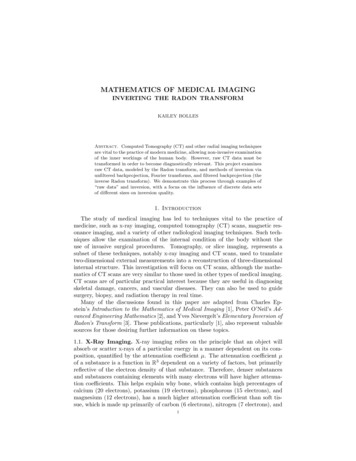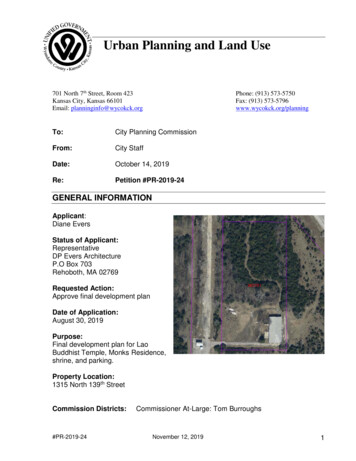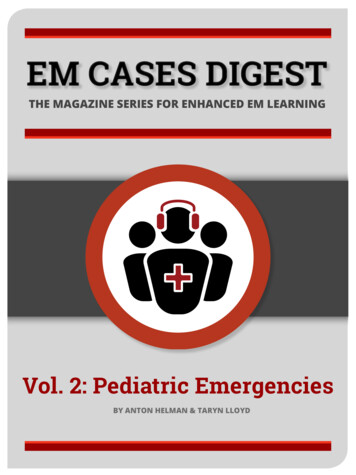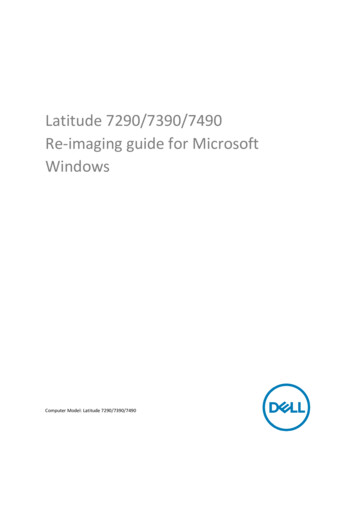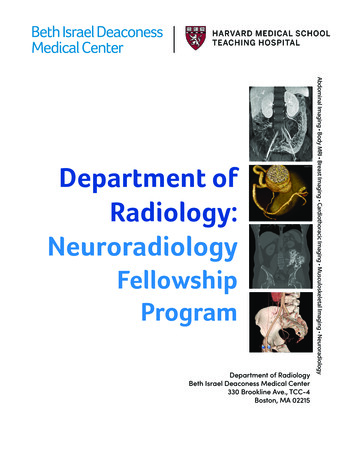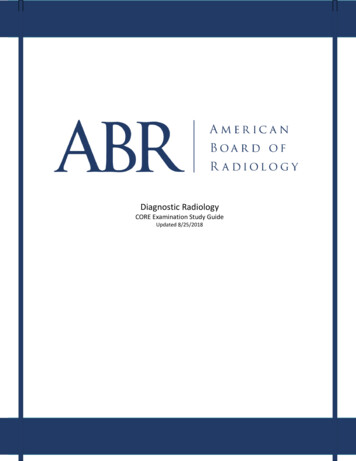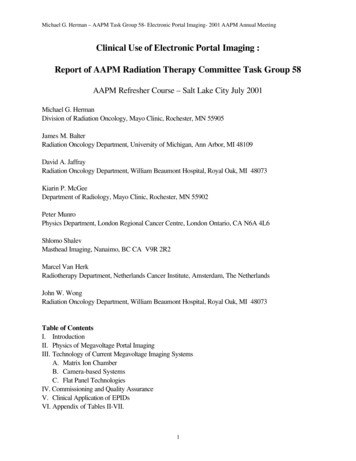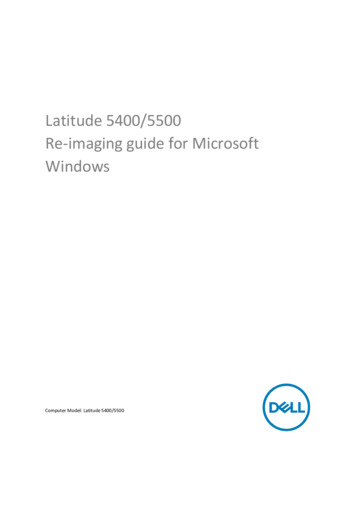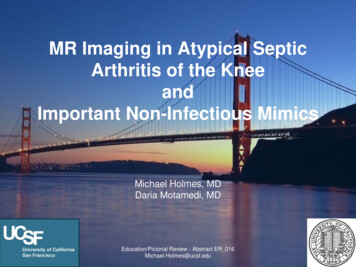
Transcription
MR Imaging in Atypical SepticArthritis of the KneeandImportant Non-Infectious MimicsMichael Holmes, MDDaria Motamedi, MDEducation/Pictorial Review - Abstract ER 016Michael.Holmes@ucsf.edu
Disclosures No Disclosures
Teaching Points Review imaging of atypical septic arthritis inthe knee Highlight pitfalls in diagnosis including noninfectious mimics Demonstrate a role for MR imaging in thediagnostic workup of subacute to chronicmonoarticular joint pain
Typical vs Atypical Septic ArthritisInfectious process of the joint which commonly involves multiple compartments including the synovium,ligaments, tendons, cartilage, bone and surrounding soft tissuesPyogenic (Typical) Infection Etiology Bacteria“Characteristic Clinical Presentation” rapid onset fever acute pain and swelling monoarticular (50% of cases involve the knee)Diagnosis Arthrocentesis - first-line step and definitive diagnosis MRI - not routinely obtained
Typical vs Atypical Septic ArthritisInfectious process of the joint which commonly involves multiple compartments including the synovium,ligaments, tendons, cartilage, bone and surrounding soft tissuesNon-Pyogenic (Atypical) Infection Etiology Mycobacteria Fungi Lyme disease Viruses“Diagnostic Challenge” - clinical presentation (NOT ALWAYS) characteristic insidious onset fever and leukocytosis (NOT ALWAYS) present subacute to chronic pain and swelling significant overlap with non-infectious arthritidesDiagnosis Arthrocentesis - not always obtained due to non-specific clinical presentation MRI - can be useful to identify evidence of infection and aid in differentiationfrom non-infectious etiologies of arthritis
MR Imaging - Septic ArthritisMR imaging plays a greater role in the diagnostic workup of non-pyogenic (atypical) septicarthritisMRI Findings joint effusion (particularly if complex) intermediate T1/T2 signal capsular outpouchings synovial thickening and intense enhancement perisynovial edema marrow edema /- osteomyelitis confluent low T1 signal, enhancement joint erosions ( /- enhancement) cartilage loss soft tissue edema ( /- enhancement) abscessesSeptic Arthritis/Osteomyelitis(Staphylococcus aureus)
Imaging/Clinical Mimics - KneeSeveral non-infectious etiologies can mimic atypical septic arthritis both clinically and on imaging Rheumatoid ArthritisSeronegative Arthropathies Psoriatic Arthritis Reactive ArthritisDeposition Disease Gout CPPD crystal deposition Hydroxyapetite depositionMass-Like Arthropathies Pigmented Villonodular Synovitis Synovial Osteochondromatosis Lipoma AborescensTumorsPsoriatic ArthritisThe following slides will present several cases of non-pyogenic septic arthritis and noninfectious mimics in the knee to not only demonstrate the similarities and potentialpitfalls but also highlight specific clinical and radiologic signs that can aid in diagnosis.
Case 1 42 year old female on chronicimmunosuppressive therapy presenting with18 months of worsening pain and swelling ofthe left knee. Patient recently moved to theU.S. from the Philippines.
Case 1Tuberculosis. a.) Sagittal T1, b) Sagittal T2 and c.) Sagittal T1 post gadolinium imagesdemonstrate periarticular erosions with surrounding marrow signal abnormality andenhancement compatible with osteomyelitis. There is a large joint effusion with T2hypointense synovial thickening and enhancement. Anterior to the tibial plateau a rimenhancing fistulous tract extends into the subcutaneous fat.
Tuberculous ArthritisEpidemiology/Risk Factors close contact to TB children and elderly immunocompromisedClinical Presentation monoarticular arthritis 1-3% of cases of TB insidious onset chronic pain and swelling systemic symptoms (fever, weight loss,night sweats) active pulmonary TB ( 50%)Imaging Synovitis synovial thickening andenhancement low T2 signal (granulomatousinflammation) Erosions peripheral AND central erosions(different than inflammatoryarthritis) Cartilage Destruction late finding (early in pyogenicinfection) Osteomyelitis low T1 signal, enhancement Abscesses Sinus Tracts
Case 2 42 year old male presenting with 12 monthhistory of gradual worsening pain andasymmetric medial swelling of the right knee.Worked previously cutting roses on a farm.
Case 2Sporotrichosis. a.) Coronal T2 demonstrates erosive defects in the medial meniscus andposterior medial oblique ligament resulting in a very large parameniscal cyst. b.) Sagittal T2and c.) sagittal T1 images demonstrates a large popliteal cyst and joint effusion withsynovitis. There is patchy reactive marrow edema in the periarticular bone but no confluentT1 hypointensity to suggest osteomyelitis. Extensive subcutaneous edema surrounds theknee.
Sporotrichosis ArthritisEpidemiology/Risk Factors middle aged men alcoholics occupational groups (farmers, florists,gardeners, fruit packers)Clinical Presentation skin disease skin/subcutaneous ulcers andnodules disseminated disease 80% joint involvement near site of inoculation monoarticular - knees (66%) chronic, indolent course avg time to diagnosis - 17 mo. up to 85% may NOT haveassociated skin disease NO constitutional symptomsImaging Synovitis synovial thickening andenhancement Erosions Reactive Marrow Edema osteomyelitis is uncommon, onlyoccurs AFTER joint infection Cartilage Destruction Bursitis Sinus Tracts 40% of cases
Case 3 35 year old female from California withhistory of gradual worsening anterior kneepain, swelling and intermittent feversfollowing hospitalization for “pneumonia” 4weeks prior.
Case 3Coccidiomycosis. a.) Axial CT chest shows a focal area of consolidation within the left upperlobe concerning for infection. b) Sagittal and c.) Axial T2 images demonstrate an infiltrativeT2 hyperintense lesion within the inferior patella with extension through the anterior cortex intothe prepatellar bursa and Hoffa’s fat pad. There is associated thickening and abnormal signalof the patellar tendon.
Coccidiomycosis ArthritisEpidemiology/Risk Factors recent travel or residence in endemicareas southwestern US South America high risk groups - Filipinos, AfricanAmericans, Mexicans, pregnancy,immunosuppressionClinical Presentation Pulmonary Infection Disseminated Disease - most commonlypresents during course of primarypulmonary infection Osteomyelitis/Septic Arthritis (10-20%)Imaging1. Lytic Bone Lesions (most common) circumscribed, punched out lesions “bony prominences” - patella,olecrenon, greater tuberosity (femur)2. Septic Arthritis 20% of MSK infections knee - most common ALWAYS occurs from direct extensionfrom adjacent osteomyelitis findings - synovitis, cartilagedestruction, periarticular erosions,bursitis, soft tissue edema
Case 4 48 year old male with history of HIV (CD4 500) presenting with 3 weeks of pain andswelling of the right knee. Synovial fluidanalysis was culture negative with elevatedWBCs.
Case 4HIV-Associated Arhritis. a.) Sagittal T1 b) Sagittal T2 and c.) Axial T2 images demonstratea large joint effusion with associated subcutaneous, intramuscular and deep fascial edemapredominantly within the medial soft tissue. No marrow signal abnormality or erosions.
HIV-Associated ArthritisEpidemiology/Risk Factors high CD4 counts ( 500)Clinical Presentation mild subacute pain and swelling assymetric polyarthritis knees and ankles self limiting (1 week - 6 months) NO extra-articular symptoms synovial fluid culture are sterile related to immune complexes in thesynoviumImaging Large Joint Effusions Soft Tissue Swelling Erosions uncommon NO cartilage destruction Non-deforming
Case 5 56 year old female with history of increasingright knee pain with morning stiffness andwarmth following a “fall” two year ago. Shereports less severe pain in her left knee andbilateral wrists.
Case 5Rheumatoid Arthritis. a.) Sagittal T2 demonstrates a large joint effusion with extensivesynovial thickening and debris. There is reactive edema in the inferior patella. b) Coronal T2and c.) Axial T2 images demonstrate erosions within the peripheral medial and lateral tibialplateau as well as the posterior lateral femoral condyle. There is complete loss of cartilagewithin the tibiofemoral compartments.
Rheumatoid ArthritisEpidemiology/Risk Factors prevalence - 1% (5% in NativeAmerican populations) 3:1 female to male 4th-5th decadeClinical Presentation symmetric polyarthritis usually develops first in proximal handsand wrists, but can affect feet and largejoints knees (75% of cases) insidious onset (weeks to months) constitutional symptoms are common: fatigue low grade feverImaging large joint effusion loose bodies, debris and “ricebodies” capsular outpouchings (popliteal cysts) synovitis low T2 signal thickening andenhancement peripheral erosions low T1, high T2 signal withperipheral rim of enhancement marrow edema and possibleenhancement
Case 6 68 year old female with history of pain andswelling of the left knee with intermittent lowgrade fever x 3 weeks. Patient reportssimilar “attacks” in the past. History of backsurgery 1 month ago.
Case 6Acute CPPD Arthritis. a.) AP radiograph demonstrates extensive chondrocalcinosis withinthe medial and lateral tibiofemoral joint compartments. b) Coronal T2 image demonstratesenlargement and abnormal punctate signal within the medial meniscus without discrete tear.c.) Sagittal T1 post-gadolinium image demonstrates a moderate joint effusion with synovialthickening, enhancement and surrounding mild muscular enhancement.
Acute CPPD ArthritisEpidemiology/Risk Factors prevalence of CPPD - 0.1% 50% in adults 80 yearsClinical PresentationAcute CPPD Arthritis - “Pseudogout” episodic acute “attacks” affects 10-20% of patients withCPPD pain, swelling, redness, warmth fever, leukocytosis often provoked by trauma, severemedical illness or surgery(hypocalcemia)Imaging Plain Film and CT very useful in diagnosis of CPPD calcification within articularcartilage, menisci, syovium,tendons and ligaments joints not typically involved with OA(patellofemoral, radiocarpal, etc) MRI Chondrocalcinosis linear or punctuate areas oflow signal representingsusceptibility“Pseudogout” synovitis capsular outpouchings perisynovial edema /enhancement marrow edema
Case 7 30 year old female presents with acute onsetof pain and swelling of the left knee x4weeks with multiple episodes of “locking”.She denies history of trauma.
Case 7Pigmented Villonodular Synovitis. a.) Sagittal T1, b.) Sagittal T2 and c.) Axial T2 imagesdemonstrate a T1/T2 hypointense mass within the posterior Hoffa’s fat pad with associatedsurrounding edema. There is a moderate effusion with pericapsular edema and extensivesynovitis.
Pigmented Villonodular SynovitisEpidemiology/Risk Factors prevalence: 11 per 1,000,000 3rd and 4th decadeClinical Presentation monoarticular knees (most common) acute onset swelling out of proportion to pain decreased ROM subjective feeling of joint “locking” or“catching"Imaging synovitis irregular, nodular or diffusethickening of the synovium T1 - heterogeneous low signalareas with high signalrepresenting hemorrhage or lipidladen macrophages T2* - “blooming” due tohemosiderin heterogeneous enhancement perisynovial edema joint effusions rarely fluid-fluid levels /- erosions (50%)
Case 8 11 year old male with development ofpainless swelling of the left kneeapproximately 3 months following a fall“down 20 stairs”. Diagnostic x-rays at thetime of the fall were negative.
Case 8Lipoma Arborescens. a.) Axial T1 image demonstrates high signal frond-like synovialmasses within the suprapatellar joint space associated with a moderate joint effusion. b) AxialT2 and c.) Sagittal T2 fat saturation images demonstrate loss of signal within the frond-likesynovial masses compatible with fat.
Lipoma ArborescensEpidemiology/Risk Factors children to adults most common - 5th-7th decades males femalesClinical Presentation insidious onset chronic swelling without pain monoarticular most common - suprapatellar pouchof the knee non-specific synovial reaction toinflammation or prior traumaImaging Frond-like Synovial Masses T1 hyperintense STIR and T2 fat saturation - loss ofsignal compatible with fat signal Overlying Synovial Enhancement Large Joint Effusions
Case 9 76 year old male with history of metastaticlung cancer, development of left knee painand swelling x 4 weeks.
Case 9Osseous Metastases. a.) Coronal T1 image demonstrates a hypointense marrow replacing lesionwithin the lateral femoral condyle. b) Sagittal T2 image demonstrates T2 fluid signal of the lesion withabnormal surrounding marrow signal. There is a large joint effusion. c.) Axial T1 post-gadoliniumimage demonstrates peripheral enhancement of the lesion and infiltration of the surrounding marrow.
Metastatic DiseaseEpidemiology/Risk Factors distal appendicular skeletalmetastases beyond the knee or elbowjoints are relatively uncommonClinical Presentation localized pain, swelling pathological fractures malignancies that most commonlyspread to the appendicular skeleton lung breast renal prostateImaging Intramedullary Lesions low-intermediate signal on T1/PD high signal on T2 and T2 FS enhancement sclerotic lesions - low T1, mixedlow/high T2 signal Extra-Osseous Extension intosurrounding soft tissues and joints joint effusions
Conclusions1. MRI is not routinely obtained in the setting of acute pyogenic septicarthritis but can be very useful in patients presenting with noncharacteristic subacute to chronic, monoarticular pain2. Differential diagnosis for atypical (non-pyogenic) septic arthritisincludes several non-infectious arthritides.3. Although MR imaging of atypical septic arthritis can overlapsignificantly with non-infectious arthritides there are findings uniqueto certain etiologies: TB - T2 hypointense synovium, soft tissue abscesses, sinustracts, central AND peripheral erosions Sporotrichosis - sinus tracts within the adjacent soft tissue Coccidiomycosis - osseous lesions HIV-Associated Arthritis - effusions WITHOUT cartilagedestruction
Conclusions continued 4. Clinical presentation should help guide imageinterpretation. Important clues are often present in the history,physical exam and lab values. TB - risk factors, pulmonary disease, constitutional symptoms Sporotrichosis - occupational exposures, skin disease Coccidiomycosis - endemic areas, high risk populationgroups, pulmonary disease HIV-Associated Arthritis - HIV with CD4 5005. Ultimately, tissue sampling (arthrocentesis, synovial biopsy) willneed to be performed to make the definitive diagnosis and guidetreatment, but MRI can be useful to suggest the presence ofinfection (possibly when not expected) and help differentiate fromother non-infectious mimics.
References Graif M, Schweitzer ME, Deely D, Matteucci T. “ The Septic versus Nonseptic Inflamed Joint: MRI characteristics”. SkeletalRadiology (1999) 28: 616-620 Resnick D. “Osteomyelitis, Septic Arthritis and Soft Tissue Infection: Organisms”. Diagnosis of Bone and Joint Disorders, 4thEdition. (2002) 2510-2625 Hollenberg GM, Weinberg EP, Meyers SP. "Lesions within Joints”. Differential Diagnosis in Musculoskeletal MRI (2015) 566-569 Karchevsky M, Schweitzer ME, Morrison WB, Parellada JA. “MRI Findings of Septic Arthritis and Associated Osteomyelitis inAdults”. AJR (2004) 182: 119-122 Sanghvi DA, Iyer VR, Deshmukh T, Hoskote S. “MRI Features of Tuberculosis of the Knee.” Skeletal Radiolol (2009) 38: 267-273 Chowdhary G, Weinstein A, Klein R, Mascarenhas BR. “Sporotrichal Arthritis”. Annals of Rheumatic Diseases (1991) 50:112-114 Zeppa A, Laorr A, Greenspan A, McGahan JP, Steinbach LS. “ Skeletal coccidiomycosis: Imaging Findings in 19 patients“. Skeletal Radiology (1996) 25: 337-343 Tehranzadeh, J, Ter-Oganesyan RR, Steinbach LS. “Musculoskeletal Disorders Assocaited with HIV Infection and AIDS. PartII: Non-Infectious Musculoskeletal Conditions”. Skeletal Radiology (2004) 33: 311-320 Sommer OJ, Klodosek A, Weiler V, Czembirek H, Boeck M, Stiskal M. “Rheumatoid Arthritis: A Practical Guide to State-of-the-ArtImaging, Image Interpretation, and Clinical Implications”. Radiographics (2005) 25: 381-398 Steinbach LS, Resnick D. “Calcium Pyrophosphate Dihydrate Crystal Deposition Disease”. Current Problems in DiagnosticRadiology (2000) 29(6) 208-227 Al-Nakshabandi NA, Ryan AG, Choudur H, Torreggiani W, Nicoloau S, Munk PL, Al-Ismail K. “Pigmented VillonodularSynovitis”. Clinical Radiology (2004) 59: 414-420
Imaging/Clinical Mimics - Knee . Several non-infectious etiologies can mimic atypical septic arthritis both clinically and on imaging Rheumatoid Arthritis Seronegative Arthropathies Psoriatic Arthritis Reactive Arthritis Deposition Disease Gout CPPD crystal deposition Hydroxyapetite deposition Mass-Like Arthropathies Pigmented Villonodular Synovitis

